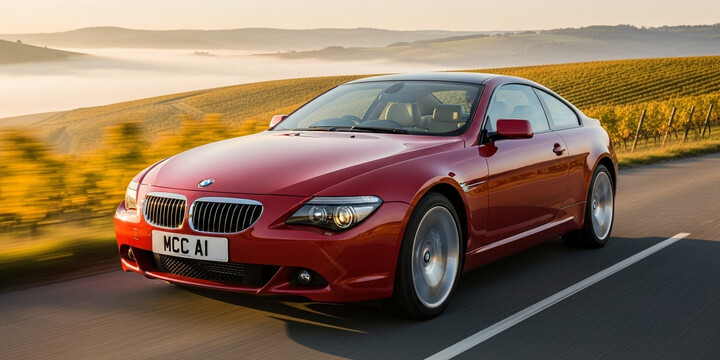
BMW 6 SERIES (2007-10)
The BMW 6 Series (2007-10) is a stylish and sophisticated coupe and convertible that stands out in the UK's used luxury car market. Known for its sleek design, refined driving experience, and premium features, this model appeals to those seeking a blend of performance and elegance. Typically used for cruising, long-distance journeys, or elevating daily commuting, the BMW 6 Series is well-suited to drivers who value comfort, sporty handling, and a touch of luxury. It’s often chosen by executives, car enthusiasts, or those who appreciate a car with a commanding presence on the road.
What makes the BMW 6 Series (2007-10) notably popular is its distinctive design, quality craftsmanship, and impressive driving dynamics. In comparison to rivals in the same class, it’s recognised for its engaging drive alongside a stylish profile and upscale interior. While it’s a reliable choice for personal use, potential buyers should be aware of its higher mileage and generally moderate number of previous owners, reflecting its desirability in the used car market. Overall, the BMW 6 Series from this era offers a compelling option for those looking to combine luxury with sporty performance in a used vehicle.

average use

The data indicates that the most common recorded mileages for BMW 6 Series (2007-10) vehicles are concentrated between 130,000 and 150,000 miles, accounting for about 16.0% of recordings. Notably, the percentage of vehicles with very high mileages above 200,000 miles is quite low, making up less than 3%, with the majority of vehicles falling below 150,000 miles. There are also small peaks around 60,000 to 80,000 miles and 90,000 to 100,000 miles, suggesting these are common intervals for service or ownership changes. Overall, the distribution indicates that most BMW 6 Series from this era are likely to have achieved moderate mileage, with relatively few reaching very high mileage thresholds.

vehicle values

The private sale valuation data for BMW 6 Series (2007-10) indicates that the most common price range is between £3,000 and £4,000, accounting for approximately 39.5% of sales. The next most frequent range is £4,000 to £5,000, representing nearly 29%. Lower price brackets between £1,000 and £3,000 collectively make up a significant portion (around 23.5%), suggesting many vehicles are valued within these lower tiers. Notably, higher price ranges above £6,000 are relatively rare, each constituting less than 1% of sales, highlighting a concentration of the market in the sub-£5,000 bracket. This distribution suggests that, for this model and age, private sales predominantly happen at lower to mid-range prices, possibly reflecting factors like vehicle condition, mileage, or market demand.

production years

The data for BMW 6 Series (2007-10) shows that the majority of vehicles from this range were manufactured in 2008, accounting for 46.5% of the sample. Vehicles from 2009 and 2010 also represent significant portions, with 19.1% and 20.3% respectively. Notably, a smaller percentage—13.7%—were manufactured in 2007, the earliest year in the range. Interestingly, only a very small fraction—0.4%—are recorded as manufactured in 2024, which appears to be an anomaly or data entry error, since the model range predates this year. Overall, the distribution suggests a peak manufacturing period around 2008, with a steady number of vehicles from 2009 and 2010.

colour popularity

The data shows that the most common main paint colour for the BMW 6 Series (2007-10) is black, accounting for nearly half of all vehicles at 46.9%. Silver and grey are also popular, representing 12.5% and 19.9% respectively, indicating a preference for neutral and classic shades. Blue is the next most common at 14.1%, while white, red, blue/black, and purple are relatively rare, each making up less than 5%. Notably, the combination colours like blue/black and purple are quite uncommon, highlighting their niche appeal. Overall, dark and neutral tones dominate the colour choices for this model.

ownership cycle

The data on registered keepers for BMW 6 Series (2007-10) vehicles reveals that most vehicles have had between 3 and 7 keepers, accounting for a significant portion of the sample—specifically, over 51% (10.2% with 3 keepers, 17.6% with 5 keepers, 12.9% with 7 keepers, and 16.4% with 4 keepers). Notably, a smaller segment has had just a single keeper (1.6%) or as many as 11 keepers (3.1%), suggesting some vehicles have been maintained with relatively stable ownership, while others have experienced multiple transfers. The distribution indicates a concentration of vehicles with moderate ownership turnover, which could imply typical ownership patterns for this model during its period.

engine choices

The data for BMW 6 Series (2007-10) vehicles indicates that the majority are equipped with engines around 3.0 litres, with approximately 65.6% having a 2,993cc engine and 19.9% a 2,996cc engine, suggesting this is the most common engine capacity for this model range. Additionally, a significant 68.8% of these vehicles run on diesel, highlighting a preference for diesel engines within this group, while petrol-powered models constitute roughly 31.3%. The relatively low occurrences of other engine sizes, such as 4.8 litres or 5.0 litres, suggest that larger engines are less common in this series.












